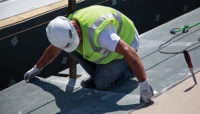The One Constant


|
| Pick up EXCLUSIVE content here! |
It never fails: change is hard. Even when most everything goes well, it is hard. We have been going through change in our shop implementing a new GPS-based
I was recently invited to listen in as a group of roofing-industry interests worked together to lobby the U.S. Green Building Council (USGBC) on proposed changes to LEED in their new standard that was first titled LEED 2012. According to the USGBC, LEED, “provides building owners and operators with a framework for identifying and implementing practical and measurable green building design, construction, operations and maintenance solutions.”
So why should the USGBC or LEED matter to the roofing industry? And what changes upset some of our brethren to the point that they were actively joining forces to lobby the USGBC?
The USGBC has grown exponentially since its founding just under 20 years ago. The market for green building products and green construction has likewise grown exponentially. LEED is only about 12 years old as a rating system, but the USGBC estimates that they are certifying more than 1.6 million square feet of space every day. That may not hit every job you work on but it is a significant and growing number.
As for the changes to LEED 2012, they have been set aside at this point. Changes to the LEED rating system are currently under review in what is cited as a consensus-based review and update. An initiative was put forward that would have, in effect, downgraded the use of roughly 90 percent of all roofing materials presently on the market due to concerns about the chemicals they contained.
Before the initiative moved forward, it and a subsequent proposal were withdrawn and the window of time for the review process for all of LEED 2012 was extended into next year. In the same announcement the USGBC stated that the existing LEED 2009 will remain available for registration for three years. So, it seems that the consensus-based approach worked as the USGBC stated that the reason for moving back the deadline for approving changes was due to feedback from their constituents.
I think having standards such as LEED, or the RoofPoint rating system, which is sponsored by the Center for Environmental Innovation in Roofing and the Roofing Industry Alliance for Progress, is a good thing. I think these voluntary rating systems will challenge owners to demand better and more efficient built spaces. I also think that the consensus-based approach to building and upgrading these systems is a vital to maintain their legitimacy. Veering off core values, including the process for change, is ill advised and those of us in the roofing business need to stay tuned regarding emerging changes such as those in the works with LEED.
Speaking of change, the USGBC changed LEED 2012 to LEED v4. This was obviously prompted by their pushing back the timetable for implementation. That was a good change, if only for marketing purposes, because it will allow further upgrades to be made without the distraction of a calendar. But it was doubtless hard to make.
 More Information More Information
|
|
For more information, visit these websites: 2. http://www.usgbc.org/DisplayPage.aspx?CMSPageID=2360 3. http://usgbcblog.blogspot.com/2012/06/important-news-about-leed-2012-message.html 4. http://www.usgbc.org/DisplayPage.aspx?CMSPageID=1988 |
Looking for a reprint of this article?
From high-res PDFs to custom plaques, order your copy today!




